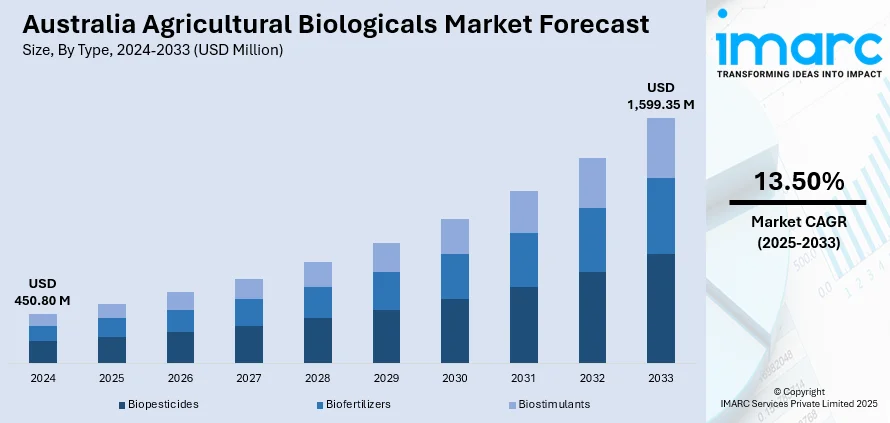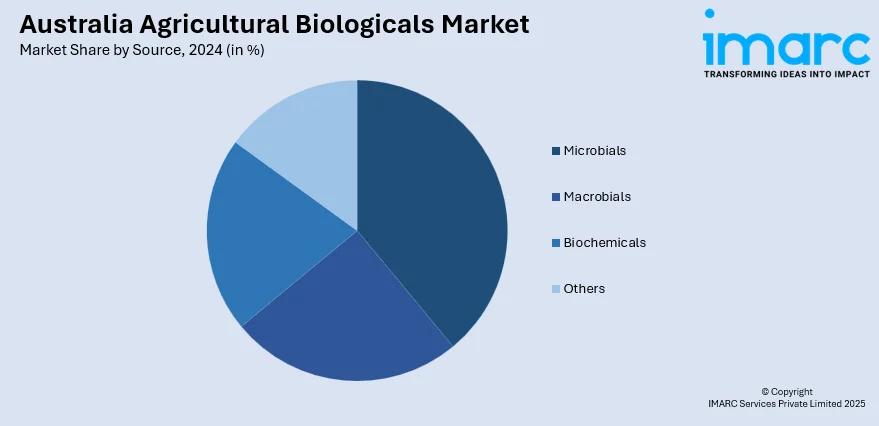
Australia Agricultural Biologicals Market Size, Share, Trends and Forecast by Type, Source, Crop Type, Mode of Application, and Region, 2025-2033
Australia Agricultural Biologicals Market Overview:
The Australia agricultural biologicals market size reached USD 450.80 Million in 2024. Looking forward, IMARC Group expects the market to reach USD 1,599.35 Million by 2033, exhibiting a growth rate (CAGR) of 13.50% during 2025-2033. The market is driven by increasing demand for organic and sustainable farming, rising consumer awareness of chemical-free produce, government incentives for eco-friendly practices, and advancements in biotechnology. Additionally, export market regulations and the need for soil health improvement are encouraging farmers toward biological alternatives is impelling the Australia agricultural biologicals market share.
|
Report Attribute
|
Key Statistics
|
|---|---|
|
Base Year
|
2024 |
|
Forecast Years
|
2025-2033
|
|
Historical Years
|
2019-2024
|
| Market Size in 2024 | USD 450.80 Million |
| Market Forecast in 2033 | USD 1,599.35 Million |
| Market Growth Rate 2025-2033 | 13.50% |
Australia Agricultural Biologicals Market Trends:
Rising Demand for Sustainable and Organic Farming Practices
Australia’s agricultural sector is rapidly shifting toward sustainability, fueled by growing consumer demand for organic produce and supportive government environmental policies. Agricultural biologicals, such as biofertilizers, biopesticides, and biostimulants are gaining traction as eco-friendly alternatives to synthetic chemicals, helping improve soil health, reduce residues, and enhance crop resilience naturally. This movement is reinforced by Australia’s leading position in organic farming, with over 53 million hectares of certified organic farmland, accounting for nearly 70% of the world’s total. Biologicals are also essential for meeting stringent residue limits in key export markets like the EU and Japan. As certification for organic farming often requires or favors biological inputs, thus supporting the Australia agricultural biologicals market growth. This trend is advancing integrated pest management (IPM) and regenerative agriculture practices across Australia's diverse and globally connected farming landscape.

To get more information on this market, Request Sample
Technological Advancements and R&D in Biological Formulations
Advances in biotechnology, microbiology, and precision agriculture are transforming the effectiveness and accessibility of agricultural biologicals in Australia. With approximately 72 % of Australian farmers adopting AgTech—especially farm management software for paddock mapping, genetics, and water monitoring (Roy Morgan)—digital tools play a vital role in optimizing biological input use. Research institutions and private firms are heavily investing in research and development (R&D) to create next-generation biologicals with improved shelf life, broader spectrum activity, and better compatibility with farming practices. Cutting-edge innovations like encapsulation, microbial consortia, and nanoformulations are enhancing delivery and efficacy. The integration of soil health monitoring and artificial intelligence (AI) driven crop diagnostics enables precise, data-informed application. Moreover, active collaboration among biotech startups, universities, and agribusinesses is accelerating product development and regulatory approval, making high-performance biologicals increasingly attractive to both large-scale and smallholder farmers across Australia.
Government Support and Regulatory Streamlining
The Australian government is actively advancing the agricultural biologicals market through supportive policies, funding, and regulatory reforms. Key initiatives include grants for sustainable farming, incentives for organic transitions, and agri-tech innovation funding, all aimed at encouraging biological input adoption. Regulatory body APVMA is streamlining evaluation processes, reducing time-to-market for biologicals while maintaining rigorous safety standards—boosting commercialization and farmer confidence. These efforts align closely with Australia’s Strategy for Nature 2024–2030, which sets targets to conserve 30% of the country’s land and marine areas and restore priority degraded ecosystems by 2030. The strategy recognizes biologicals as vital tools for reducing agrochemical dependency, supporting biodiversity, and building climate resilience. Together, these frameworks position biologicals as central to Australia’s sustainable agricultural future and environmental conservation goals.
Australia Agricultural Biologicals Market Segmentation:
IMARC Group provides an analysis of the key trends in each segment of the market, along with forecasts at the country and regional levels for 2025-2033. Our report has categorized the market based on type, source, crop type, and mode of application.
Type Insights:
- Biopesticides
- Biofertilizers
- Biostimulants
The report has provided a detailed breakup and analysis of the market based on the type. This includes biopesticides, biofertilizers, and biostimulants.
Source Insights:

- Microbials
- Macrobials
- Biochemicals
- Others
A detailed breakup and analysis of the market based on the source have also been provided in the report. This includes microbials, macrobials, biochemicals, and others.
Crop Type Insights:
- Cereals and Grains
- Oilseed and Pulses
- Fruits and Vegetables
- Turf and Ornamentals
- Others
The report has provided a detailed breakup and analysis of the market based on the crop type. This includes cereals and grains, oilseed and pulses, fruits and vegetables, turf and ornamentals, and others.
Mode of Application Insights:
- Foliar Spray
- Soil Treatment
- Seed Treatment
- Post-Harvest
A detailed breakup and analysis of the market based on the mode of application have also been provided in the report. This includes foliar spray, soil treatment, seed treatment, and post-harvest.
Regional Insights:
- Australia Capital Territory & New South Wales
- Victoria & Tasmania
- Queensland
- Northern Territory & Southern Australia
- Western Australia
The report has also provided a comprehensive analysis of all the major regional markets, which include Australia Capital Territory & New South Wales, Victoria & Tasmania, Queensland, Northern Territory & Southern Australia, and Western Australia.
Competitive Landscape:
The market research report has also provided a comprehensive analysis of the competitive landscape. Competitive analysis such as market structure, key player positioning, top winning strategies, competitive dashboard, and company evaluation quadrant has been covered in the report. Also, detailed profiles of all major companies have been provided.
Australia Agricultural Biologicals Market News:
- In June 2024, Platform 10, founded by Western Growers Association and Wharf42, launched a global grower trial network to accelerate the adoption of agricultural biologicals. Announced at the Salinas Biological Summit, trials will begin in California and expand to Australia, New Zealand, the UK, and Denmark. The initiative addresses global challenges like rising chemical resistance, regulatory restrictions, and demand for residue-free produce.
- In March 2024, ADAMA teamed up with Elemental Enzymes to introduce an innovative bio-fungicide into the Australian market. Scheduled for 2026, it attacks foliar crop and turf diseases through peptide technology that enhances plant defense and is used in addition to chemical fungicides. ADAMA will exclusively market the product for broadacre crops and turf.
Australia Agricultural Biologicals Market Report Coverage:
| Report Features | Details |
|---|---|
| Base Year of the Analysis | 2024 |
| Historical Period | 2019-2024 |
| Forecast Period | 2025-2033 |
| Units | Million USD |
| Scope of the Report |
Exploration of Historical Trends and Market Outlook, Industry Catalysts and Challenges, Segment-Wise Historical and Future Market Assessment:
|
| Types Covered | Biopesticides, Biofertilizers, Biostimulants |
| Sources Covered | Microbials, Macrobials, Biochemicals, Others |
| Crop Types Covered | Cereals and Grains, Oilseed and Pulses, Fruits and Vegetables, Turf and Ornamentals, Others |
| Mode of Applications Covered | Foliar Spray, Soil Treatment, Seed Treatment, Post-Harvest |
| Regions Covered | Australia Capital Territory & New South Wales, Victoria & Tasmania, Queensland, Northern Territory & Southern Australia, Western Australia |
| Customization Scope | 10% Free Customization |
| Post-Sale Analyst Support | 10-12 Weeks |
| Delivery Format | PDF and Excel through Email (We can also provide the editable version of the report in PPT/Word format on special request) |
Key Questions Answered in This Report:
- How has the Australia agricultural biologicals market performed so far and how will it perform in the coming years?
- What is the breakup of the Australia agricultural biologicals market on the basis of type?
- What is the breakup of the Australia agricultural biologicals market on the basis of source?
- What is the breakup of the Australia agricultural biologicals market on the basis of crop type?
- What is the breakup of the Australia agricultural biologicals market on the basis of mode of application?
- What is the breakup of the Australia agricultural biologicals market on the basis of region?
- What are the various stages in the value chain of the Australia agricultural biologicals market?
- What are the key driving factors and challenges in the Australia agricultural biologicals market?
- What is the structure of the Australia agricultural biologicals market and who are the key players?
- What is the degree of competition in the Australia agricultural biologicals market?
Key Benefits for Stakeholders:
- IMARC’s industry report offers a comprehensive quantitative analysis of various market segments, historical and current market trends, market forecasts, and dynamics of the Australia agricultural biologicals market from 2019-2033.
- The research report provides the latest information on the market drivers, challenges, and opportunities in the Australia agricultural biologicals market.
- Porter's five forces analysis assist stakeholders in assessing the impact of new entrants, competitive rivalry, supplier power, buyer power, and the threat of substitution. It helps stakeholders to analyze the level of competition within the Australia agricultural biologicals industry and its attractiveness.
- Competitive landscape allows stakeholders to understand their competitive environment and provides an insight into the current positions of key players in the market.
Need more help?
- Speak to our experienced analysts for insights on the current market scenarios.
- Include additional segments and countries to customize the report as per your requirement.
- Gain an unparalleled competitive advantage in your domain by understanding how to utilize the report and positively impacting your operations and revenue.
- For further assistance, please connect with our analysts.
 Request Customization
Request Customization
 Speak to an Analyst
Speak to an Analyst
 Request Brochure
Request Brochure
 Inquire Before Buying
Inquire Before Buying




.webp)




.webp)












